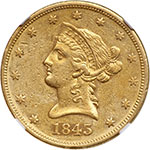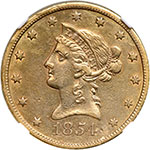
|
Sale 81
The Pre-Long Beach Sale
| Lot |
Photo |
Description |
Realized |
Lot 1304 |
 |
1843. NGC graded AU-58. Only 75,462 struck, of which merely 175 examples are estimated to have survives. A low-mintage Philadelphia Mint Eagle from the 1840s. By 1838, Congress had reduced the weight and fineness of the Eagle to 16.718 grams and .900 gold, respectively. These reductions, though slight, were deemed adequate to discourage the widespread hoarding and exportation that plagued the denomination earlier and led to the Eagle�s suspension in 1804. Mint Director Robert Maskell Patterson received orders to resume coinage in July 1838. A new design was selected: the Coronet or Liberty motif of Acting Mint Engraver Christian Gobrecht. The portrait of Liberty is similar to the head of Venus used in Benjamin West's recent painting Omnia Vincit Amor, and the reverse eagle is more realistic than either of those which appeared on the Capped Bust Right Ten of 1795-1804. Gobrecht's original model was in use only through June 1839, after which he redesigned Liberty's portrait to the version that would remain essentially unchanged through 1907. One final, major design change took place in 1866, and that was the introduction of the motto IN GOD WE TRUST on a scroll in the upper-reverse field. That year, therefore, forms a convenient break in this long-lived series, with pieces struck from 1838-66 displaying the No Motto type and those of the 1866-1907 era the Motto type. The No Motto series is extremely tricky to pursue since many issues are rare in an absolute sense and many unavailable in Mint condition. Pop 21; 5 finer, 1 in 58 Star, 3 in 60, 1 in 61. (PCGS # 8588) .
Estimated Value $5,000 - 5,250.
View details and enlarged photos
Check results on similar lots
| Realized
$5,875 |
Lot 1305 |
 |
1845/1845-O VP-002. NGC graded MS-60. Nice bold strike with a clearly seen overdate. Lustrous throughout. Pre Civil War gold from the New Orleans Mint is rare because of low original mintages and low survival rates. Garrett and Guth in their Encyclopedia say of the 1845-O eagle, "Mint State examples are exceedingly rare." In its population report, NGC shows 1 1845/1845-O eagle in MS60 condition with none finer. At PCGS the finest known is an AU58.
This Mint State, Southern branch mint repunched date 1845-O eagle is the finest known at both NGC and PCGS. The coin, which shows original mint luster within its devices, is a mixture of light and dark yellow gold. These colors indicated the coin�s originality. The surfaces are clean for the grade with no notable abrasion marks or other distractions. The strike is strong with full details on the centers of the stars, Liberty's hair, the eagle�s neck, and the area to the lower left of the shield.
Between 1805, when President Thomas Jefferson ordered mintage of gold eagles stopped, and 1837 no gold eagles were made. Coinage was of this denomination was resumed with Christian Gobrecht's Liberty Head eagle. The size, weight, and fineness were reduced so that the coins were not intrinsically worth more than their denominated value.
The Liberty Head eagle shows Liberty facing left in profile wearing a LIBERTY inscribed coronet with her hair tied in the back in beads. Two long curls hang down her neck, one in the back and the other on the side. She is surrounded with thirteen six-pointed stars. The date is below the truncation, which shows no drapery. The motif is taken from a Benjamin West painting of Venus. It was also used with modifications for the Large Cents of 1839. The reverse shows a heraldic eagle with outstretched wing looking to the left. On its chest is the Union shield. In its talons it holds the olive branch and arrows. The error in the previous issue, Scot�s eagle held the arrows and the olive branches in the wrong talons, is corrected. Except for being interrupted by the tips of the eagle�s wings UNITED STATES OF AMERICA surrounds the reverse, separated from the denomination TEN D. by dots. Dentils are near the edge on both sides of the coin, and the edge is reeded. The mintmark is below the eagle above the denomination.
Gobrecht was the third Chief Engraver at the United States Mint. He was born in Hanover, Pennsylvania in 1785. His father was a German immigrant, and his mother traced her ancestry to the early settlers of Plymouth, Massachusetts. Gobrecht married Mary Hewes in 1818. One of his early positions was as an engraver of clocks in Baltimore. Later he went to Philadelphia where he became a banknote engraver. He invented a machine that allowed one to convert a three-dimensional medal into an illustration. This was an excellent job and Gobrecht was understandably reluctant to work for the Mint for less money than he was making at the engraving firm. In order to persuade him to leave, Mint Director Robert Patterson prevailed upon Chief Engraver William Kneass, who had had a stroke, to take less in salary so more money would be available to hire Gobrecht on a permanent basis. In 1826 Gobrecht did his first work for the Mint as an assistant to Kneass. After Kneass� stroke, Gobrecht did all the die and pattern work for the Mint. He became Chief Engraver in 1840 and served until his death in 1844. He was famous for his Liberty Seated motif, which was used for all denominations of silver coinage including the half-dime, dime, quarter dollar, half dollar and silver dollar. He also designed the Liberty Head gold eagle, a motif that was also used on the half-cent, the cent, the gold quarter eagle, and the gold half eagle.
The New Orleans Mint was authorized in 1835 by President Andrew Jackson, hero of the battle of New Orleans. The bill that Jackson signed also authorized the mints at Charlotte and Dahlonega. William Strickland, a Philadelphia architect designed all three branch mint buildings. The New Orleans Mint building was made in the solid, bulky Greek Revival style of architecture. It was the largest of the three branch mints and located at major port of entry. Unfortunately Strickland did not account for the soft ground around the site. Because of it, the building had to undergo numerous repairs throughout its history.
Authorized to produce gold and silver, the New Orleans Mint struck quarter eagles and dimes in 1839. It operated from 1838 to 1909. In that time period 427 million silver and gold coins with the O mintmark were coined. By the mid 1850�s denominations made in New Orleans included three-cent silver pieces, half-dimes, dimes, quarters, half dollars, silver dollars, gold dollars, quarter eagles, three-dollar pieces, half eagles, eagles, and double eagles. The first deposit was of Mexican dollars which amounted to more than 32,400 dollars. The first coins struck were Liberty Seated dimes. Each year between the beginning of August and the end of November, the mint closed because of the annual outbreak of yellow fever.
Pre Civil War gold from the New Orleans Mint is rare because of low original mintages and low survival rates. Garrett and Guth in their Encyclopedia say of the 1845-O eagle, "Mint State examples are exceedingly rare." In its population report, NGC shows 1 1845/1845-O eagle in MS60 condition with none finer. At PCGS the finest known is an AU58. Pop 1; none finer at NGC for the variety .
Estimated Value $12,500-UP.
View details and enlarged photos
| Realized
$16,450 |
Lot 1306 |
 |
1851-O. NGC graded AU-55. Untoned with luster still evident on both sides. Minor rim nick on the reverse edge at 4:00. As Gold Eagle specialists realize, the 1851-O is one of the more easily found New Orleans Tens. That said, Very Fine and Extremely Fine condition seem predominant. But in About Uncirculated and especially better grades of About Uncirculated the coin is definitely elusive. Coins struck in the New Orleans mint, home of the chief port in the USA in those days, were truly needed for commercial purposes. Most gold denominations went right into circulation. Most stayed there and became severely abraded. In terms of its strike, this example is fairly representative. The peripheral stars show few radial lines, while the central hair on Liberty and eagle plumage are well defined. All in all a splendid occasion to acquire a well-preserved O-mint Ten (PCGS # 8607) .
Estimated Value $2,000 - 2,200.
View details and enlarged photos
Check results on similar lots
| Realized
$1,234 |
Lot 1307 |
 |
1854-S NGC graded XF Details. Improperly cleaned. Popular first year "S" mint $10 Gold (PCGS # 8615) .
Estimated Value $850 - 900.
View details and enlarged photos
Check results on similar lots
| Unsold |
|
|